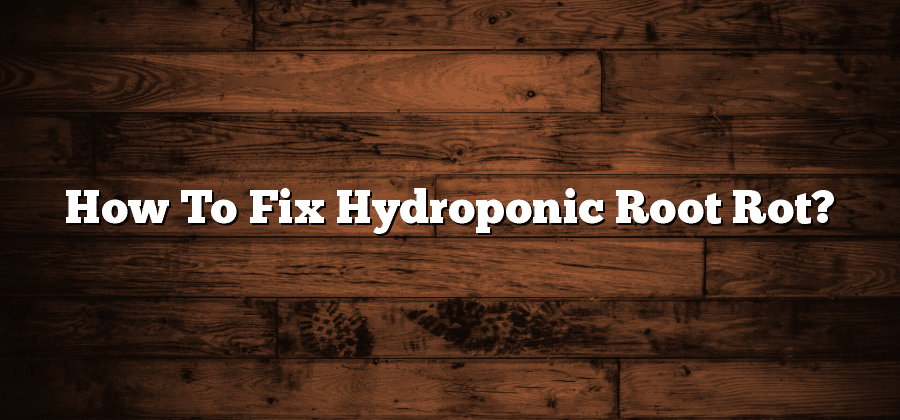Common Causes of Hydroponic Root Rot
Excessive humidity and poor ventilation are two common causes of hydroponic root rot. When the air around the plants becomes saturated with moisture and there is no way for it to escape, the roots are at risk of becoming waterlogged. This creates the perfect environment for harmful bacteria and fungi to thrive, leading to root rot. Another cause of root rot is overwatering. It’s important to strike a balance between keeping the roots hydrated and allowing them to receive enough oxygen. Overwatering can suffocate the roots, preventing them from getting the oxygen they need to function properly.
Recognizing the Symptoms of Root Rot
Root rot is a common issue that hydroponic gardeners may encounter. Recognizing the symptoms of root rot is essential in order to intervene and save the plants from further damage. One prevalent sign of root rot is the appearance of brown or black, slimy roots. Healthy roots should be white and firm, so any discoloration or softness is a clear indication of root rot.
In addition to the visual cues, an unpleasant odor may emanate from the infected roots. This odor is often described as musty or foul, and it indicates the presence of harmful bacteria or fungi. It is important to note that not all plants react the same way to root rot, and the symptoms can vary. Some plants may experience wilting leaves or stunted growth, while others may exhibit yellowing or browning of the foliage. Paying close attention to these subtler signs can help detect root rot at an early stage and prevent further spread to neighboring plants.
Choosing the Right Hydroponic System
When it comes to choosing the right hydroponic system, there are a few key factors to consider that will help you make an informed decision. Firstly, consider the space available to you. If you have limited space, a vertical system or a floating raft system may be the most suitable options. These systems maximize the use of vertical space, allowing you to grow more plants in a smaller area.
Another important factor to consider is the type of plants you want to grow. Some plants may require a certain type of hydroponic system to thrive. For example, nutrient film technique (NFT) systems are well-suited for leafy greens and herbs, while drip systems may be more suitable for larger plants like tomatoes or cucumbers.
In addition to space and plant requirements, it is also important to consider your level of expertise and available time for maintenance. Some hydroponic systems require more monitoring and adjustments, while others are more hands-off. Be sure to choose a system that fits your skills and the amount of time you can dedicate to maintaining it.
By taking into account your space, plant requirements, and personal capabilities, you will be able to choose the right hydroponic system that best suits your needs and ensures successful plant growth.
Maintaining Proper Oxygen Levels in the Solution
To ensure healthy plant growth in a hydroponic system, it is crucial to provide proper oxygen levels in the nutrient solution. Oxygen plays a vital role in the root zone, facilitating nutrient uptake and supporting root respiration. Insufficient oxygen levels can lead to the development of anaerobic conditions, promoting the growth of harmful pathogens and causing root rot.
To maintain proper oxygen levels in the solution, several factors need to be considered. Firstly, the type of hydroponic system chosen can have a significant impact on oxygen availability. Deep water culture systems, for example, provide higher oxygen levels due to the constant exposure of the roots to oxygen-rich air. On the other hand, nutrient film technique systems may require extra measures to ensure adequate oxygenation, such as implementing air stones or incorporating additional aeration devices.
Another essential aspect to consider is the temperature of the nutrient solution. Higher temperatures result in reduced oxygen solubility, leading to lower oxygen availability for the roots. Monitoring and controlling the solution temperature is crucial to maintain optimal oxygen levels. Using a water chiller or implementing cooling methods can help keep the nutrient solution within the appropriate temperature range, ensuring sufficient oxygen for root health.
Achieving and maintaining proper oxygen levels in the hydroponic system is essential for promoting healthy root growth and preventing the development of root rot. By selecting an appropriate hydroponic system and controlling the temperature of the nutrient solution, growers can optimize oxygen availability and create an ideal environment for their plants to thrive.
Implementing Effective Sterilization Practices
To ensure the success and longevity of your hydroponic system, implementing effective sterilization practices is crucial. Contaminants such as bacteria, fungi, and other pathogens can quickly take hold in the nutrient solution, leading to root rot and plant diseases. By following proper sterilization techniques, you can minimize the risk of these issues and maintain a healthy growing environment.
One essential step in sterilization is to regularly clean and sanitize all equipment used in the hydroponic system. This includes trays, reservoirs, pumps, and any tools you use during the cultivation process. Cleaning with a mild detergent and warm water can help remove debris and organic matter, while sanitizing with a bleach or hydrogen peroxide solution can kill any remaining pathogens. Remember to rinse thoroughly after using cleaning agents to avoid any residual effects on the plants.






